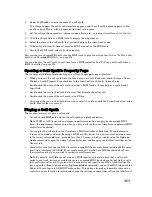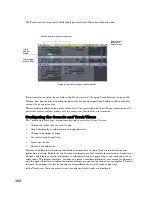
353
Engl
ish
2.
Under
Soft Synths
, choose the name of a soft synth.
Two things happen: the soft synth’s interface appears, and the soft synth’s name appears in the
track’s or bus’s FX bin, with a bypass button next to the name.
3.
Set the soft synth’s parameters (choose sounds, effects, etc.), and drag its interface out of the way.
4.
Click the Output field of a MIDI track to display the output menu.
5.
Select the name of the soft synth that you patched into the audio track or bus.
6.
If the soft synth is multi-timbral, choose a MIDI channel for the MIDI track.
7.
Also in the MIDI track, select a bank and patch.
Now you can record some MIDI data into the MIDI track to play the soft synth with. See “To Play a Soft
Synth with Recorded MIDI Data” on page 354.
You can also play the soft synth in real-time from a MIDI controller. See “To Play a Soft Synth from a
MIDI Controller” on page 354.
Opening a Soft Synth’s Property Page
There are several different methods to open a soft synth’s property page (interface):
•
When you insert the soft synth from the Insert menu or Synth Rack view, check the Open These
Windows: Synth Property Page checkbox in the Insert soft synth Synth Options dialog.
•
Double-click the name of the soft synth in either a MIDI track’s Output field or a synth track’s
Input field.
•
Double-click the row in the Synth Rack view that displays the soft synth.
•
Double-click the name of the soft synth in an FX bin.
•
Click one of the rows in the Synth Rack view to select it, and then click the Properties button in the
Synth Rack toolbar (or press
c
).
Playing a Soft Synth
There are several ways to play a soft synth:
•
You can record MIDI data and use the soft synth as a playback device.
Note
: WDM or ASIO drivers do not improve performance when you play back recorded MIDI
data—the improvement comes only when you play a soft synth in real time from an external MIDI
controller or keyboard.
•
You can play the soft synth in real time from a MIDI controller or keyboard. To avoid excessive
latency, your sound card must be using a WDM or ASIO driver. Also, you must set mixing latency
to the lowest achievable level (probably less than 10 msec.), which you do by using the
Options-
Audio
command to open the Audio Options dialog box, and dragging the Buffer Size slider on the
General tab.
•
Some soft synths that use the DXi 2 format can send MIDI data, sometimes including MIDI notes,
from their interfaces to SONAR. For example, some soft synths have MIDI keyboards built into
their interfaces that you can click to send note on/off messages.
Note
: By default, SONAR does not echo any MIDI input or automation data that a soft synth
sends to any track, but can record this data in any armed MIDI track whose Output field is set to
that particular soft synth. If you do want to echo soft synth input to any MIDI track that has the
focus, open the Global Options dialog (
Options-Global
command), and on the MIDI tab, check the
Echo Soft Synth Input to All MIDI Tracks option. This option also makes it possible to move the
controls in one soft synth’s interface and change the settings in some other soft synth’s interface, if
Summary of Contents for Cakewalk SONAR
Page 1: ...Cakewalk SONAR User s Guide ...
Page 2: ......
Page 4: ......
Page 22: ...xxii ...
Page 50: ...50 ...
Page 102: ...102 ...
Page 182: ...182 ...
Page 302: ...302 ...
Page 420: ...420 English ...
Page 466: ...466 ...
Page 502: ...502 ...
Page 574: ...574 ...
Page 580: ...580 ...
Page 608: ...608 ...
















































